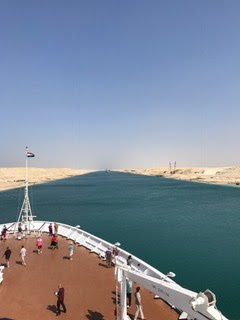The Suez Canal is an artificial waterway in Egypt constructed in the mid 1800's which links the Red Sea with the Mediterranean Sea via the Isthmus of Suez. It is about 100 miles long. Once opened, it saved ships a 4,300 mile journey to get around from the Southern Indian or South Atlantic Oceans.
About 100 ships transit the Canal every day. This is about double what it was until it was widened in 2016 in two places which allowed a greater ability for ships to pass one another while going in opposite directions.
Unlike the Panama Canal, the Suez has no system of locks. It's just a big old canal dig out of the sandy soil and silt. There were ancient canals built to facilitate east and west travel between the Nile and the Red Sea, but nothing substantial running north and south, although remnants of some ancient waterways were found and noted by historians as far back as 270 BC.
Yesterday afternoon we arrived at the mouth of the Canal at the southern end. We anchored and waited to be boarded by officials to be cleared for transit and assigned a place in line. Ships go through as convoys and you need to be lined up and ready to go by sunrise.
We started at sunrise and we were third in line. In front of us was another cruise ship followed by a massive car transport ship. Each ship is spaced about 1/2 mile apart from one another.
It is mid afternoon now - about 3:00 PM and we are just exiting using the right fork of the newest part of the Canal.
I've really enjoyed this first time passage through this marvelous Canal. Yet another highlight and another item checked off the proverbial bucket list.
Tomorrow is a day at sea and then we have 6 straight port days - all in various parts of Greece!














































